The history of the Geertekerk
The Geertekerk is the oldest venue we operate. The first mention of the Geertekerk can be found in a document from the 13th century. It describes that a certain Lodewijk, cathedral provost (second in command within the bishopric) in Utrecht, donates four parochial churches to the chapter of the Dom. The date of this document must be 1204 or 1217, as it is only in these two years that a provost with the name Lodewijk is known in Utrecht.
However, the Geertekerk referred to in this document is not the current building, but a church that stood just outside the city walls. It is likely that it stood there already before 1140, the year that the construction of the city walls began. If the church was of later date, it would have been built within the safety of these city walls.
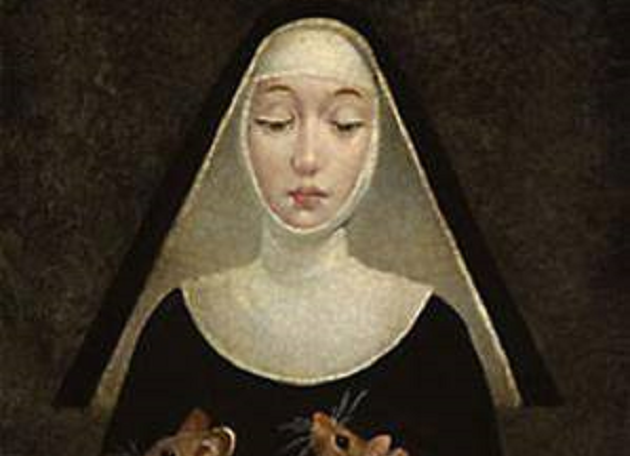
The apartment complex “Enghlen Schild” on the other side of the canal, the former Academic Hospital, is the presumed original location of the church. At the time, the canal had not been dug out yet and there must have been a small village, of which the Geertekerk was the House of God. Two letters of donation, from 1231 and 1247, and a purchase deed from 1248 still mention the church standing outside the walls.
On December 12, 1259, bishop Hendrik van Vianden transfers the old graveyard “St.Gertrude-outside-the-walls” to the German Order “after the former parish church there was deconstructed and transferred and reconstructed at a more suitable place within the walls of the city by a new graveyard.”
So in that year, the Geertekerk is inside of the city walls, at its current place. Since the deconstruction and reconstruction must have taken several years, one can assume that the present building dates from the period 1255-1259.
Because of ongoing friction between Holland and Het Sticht (the territory over which the bishops of Utrecht exercised sovereignty in the Middle Ages), the city was besieged several times. This may be the reason why the church was moved inside the city walls. The church was deconstructed and rebuilt using the stones and ornaments of the original building. As the demolition and reconstruction must have taken several years, it can be assumed that the present building dates from the period 1255-1259.
On 12 December 1259, Bishop Hendrik of Vianden hands the old churchyard of “St. Gertrude outside the walls” over to the Teutonic Order “after the former church there had been demolished and moved to a more suitable place within the walls of the city on a new churchyard”.
From that year on, the Geertekerk stands inside the walls of the city at its current location.
The church “of that time” consists of a simple Romanesque hall, located on the site of the nave of the current church. In the 14th century, the Romanesque hall was extended with a tower and, in Gothic style, the choir, transept and side aisles. In the following century, the church took on its present form. Over the years, the church has had several extensions, most of which have disappeared again.
Around 1400, a hermitage was built on the south side of the choir, where Agnes van Zantwijk lived first, and many hermits after her. Around 1850, the hermitage was used as a fire extinguisher storage and demolished in 1943.
At the site of the current verger’s house, a small extension on the north side of the north chapel was built against the tower during the 16th century. Together with the chapel, it was made into a single residence. During the last restoration, the chapel was restored to its original shape and a new verger’s house was built. Five houses were built against the south side of the church in 1715. These were removed only a few decades later, because the church was damaged due to the poor maintenance of these houses. The many graves and crypts that were once present in the church were all removed during the last restoration. Only on the outside wall of the northern chapel, against the tower, there is still a mass grave from the 17th century present. Here the victims of a plague epidemic are buried. There are also reports of a beer cellar under the tower. There was probably a room under the sacristy once, since there are still traces of a cellar entrance or cellar window in the outer wall of the sacristy.
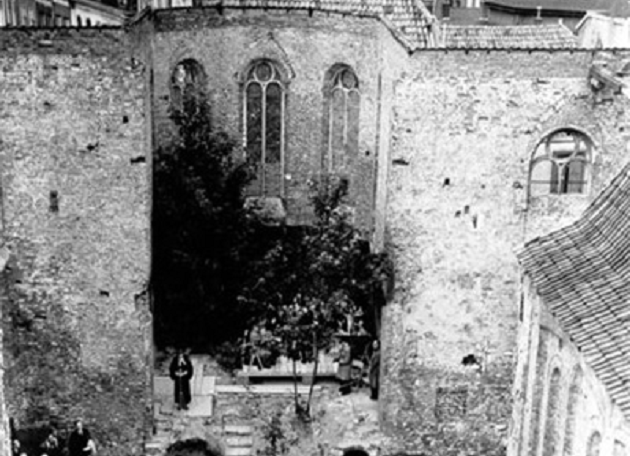
The history of the Geertekerk is eventful. For instance, the church was the first building in Utrecht to be hit by the iconoclasm, on 24 August 1566. Initially, the damage was relatively limited, but two days later the storm struck again. The church then had to be closed for seven weeks for repairs.
After the Utrecht city council banned Catholicism in 1580, the existing churches were either closed or given to the Protestants. This also happened to the Geertekerk in 1581. The Protestants then hard-handedly stripped the church of all its statues and altars after all.
The church also had a number of other functions over the years. For example, French soldiers stayed there from 1794 onwards. After their departure, the building was used by the army as a warehouse, a workshop for army tents and as a horse stable.
In 1855, the church served as a shelter for the victims of a dike breach near Veenendaal. The Veenendalers stayed in the church for about 4-6 weeks. The copper chandelier that now hangs above the choir was later donated to the Geertekerk by Veenendaal as a gesture of gratitude.
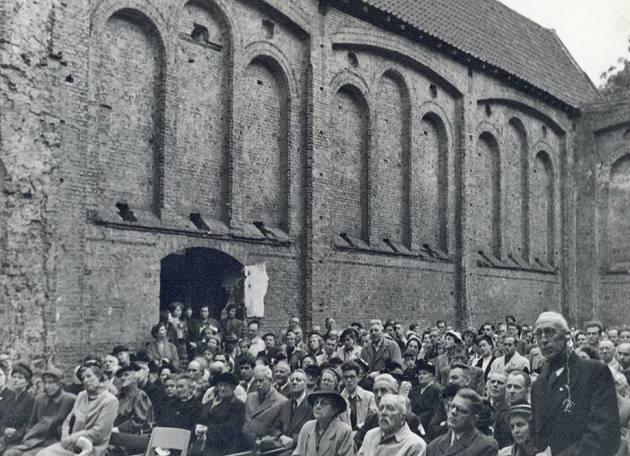
Despite all these different functions, the church increasingly fell into disrepair in the 19th century. In 1930, the building was so dilapidated that all services were discontinued and plans were made to demolish the church. Due to the outbreak of the World War II, the demolition eventually never took place. The decay continued: shrubs started growing from the remains and the Geertekerk became a ruin without a roof, as can be seen in the picture.
Finally, in 1954, the Geertekerk was sold by the Reformed Church of Utrecht to the Remonstrant Church of Utrecht. Through restoration led by the architects E.A. Canneman and D. Verheus, the Geertekerk rose again to its full glory. It was reopened as a church on 1 December 1956. Since then, the Geertekerk has been the home of the Utrecht Remonstrants.
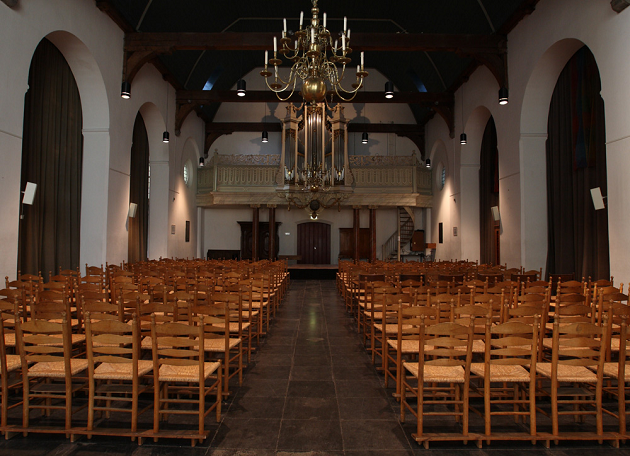
During this last restoration, the interior of the church was somewhat adapted to the wishes of the Remonstrant congregation. By erecting a new stone wall between the westernmost pillars of the central nave, an entrance hall was separated from the main church hall. An underfloor heating system was installed in the church and the remaining tombstones were collected in the choir and the side chapels. In 1980, an accessible toilet was installed in the north chapel, and later an extra floor was added in the south chapel to accommodate the church office. All inventory items still present in the church are bought or donated after the 1954 restoration.
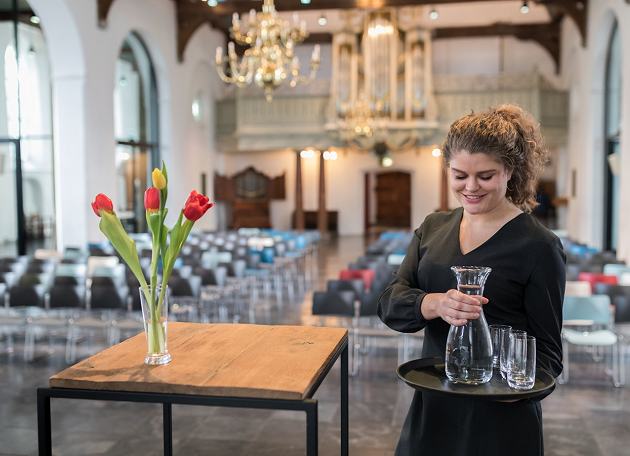
Since 2012, renting out and the operations of the Geertekerk are done by Heirloom. After an extensive renovation in 2015, the church now has two spacious foyers, perfect lighting and sound, and a professional kitchen, optimally furnished for big groups.
